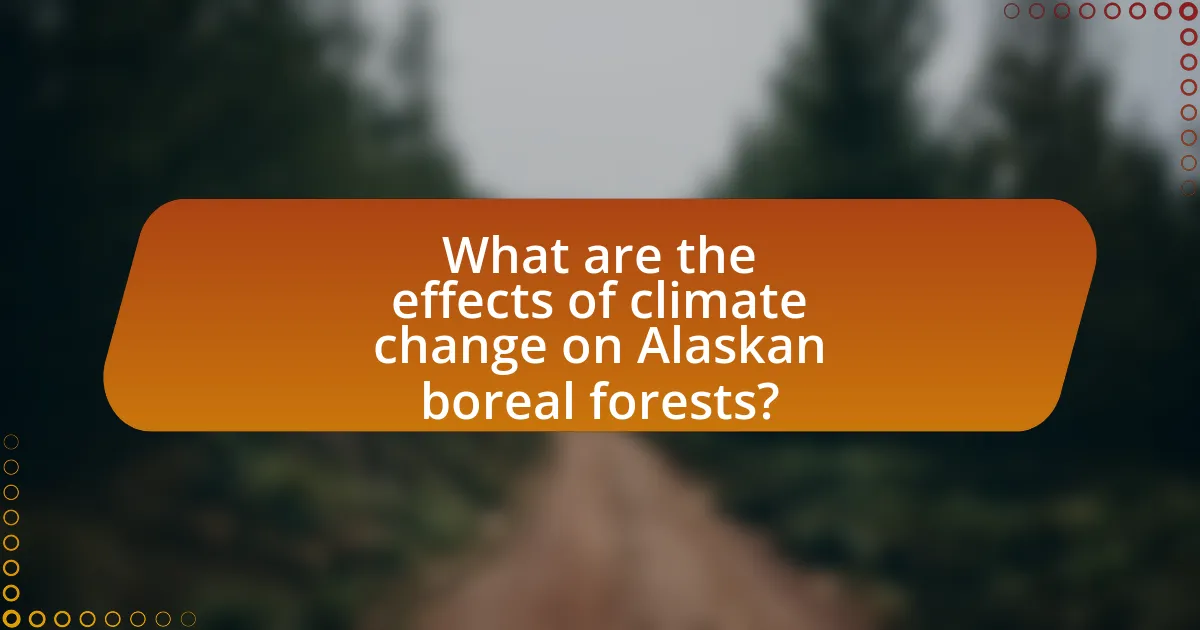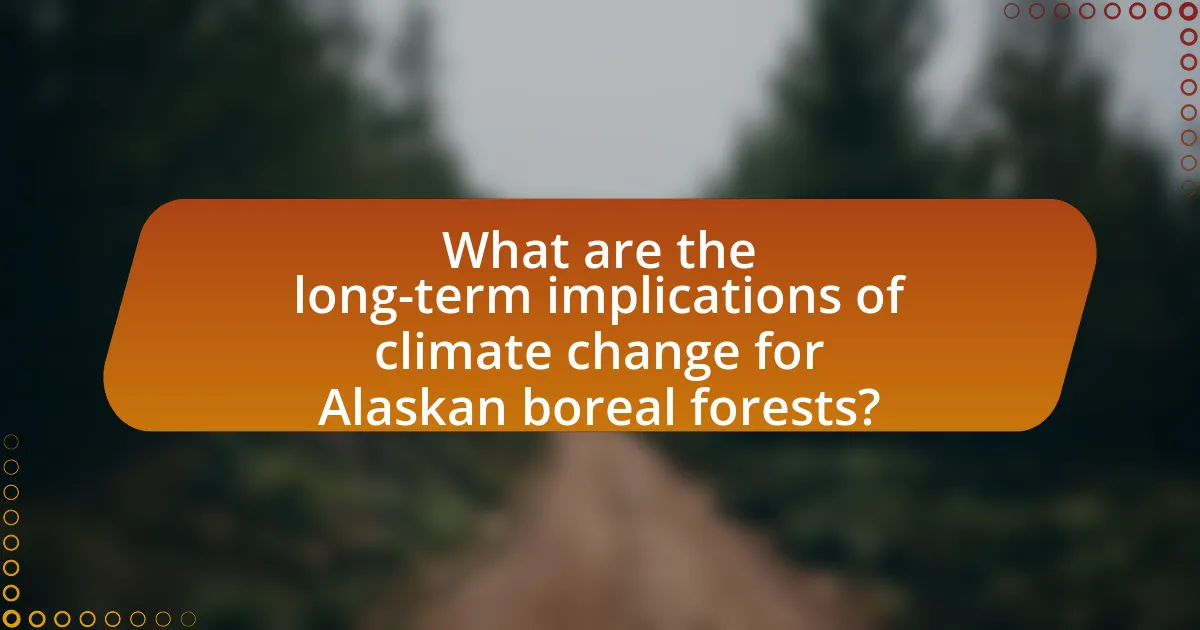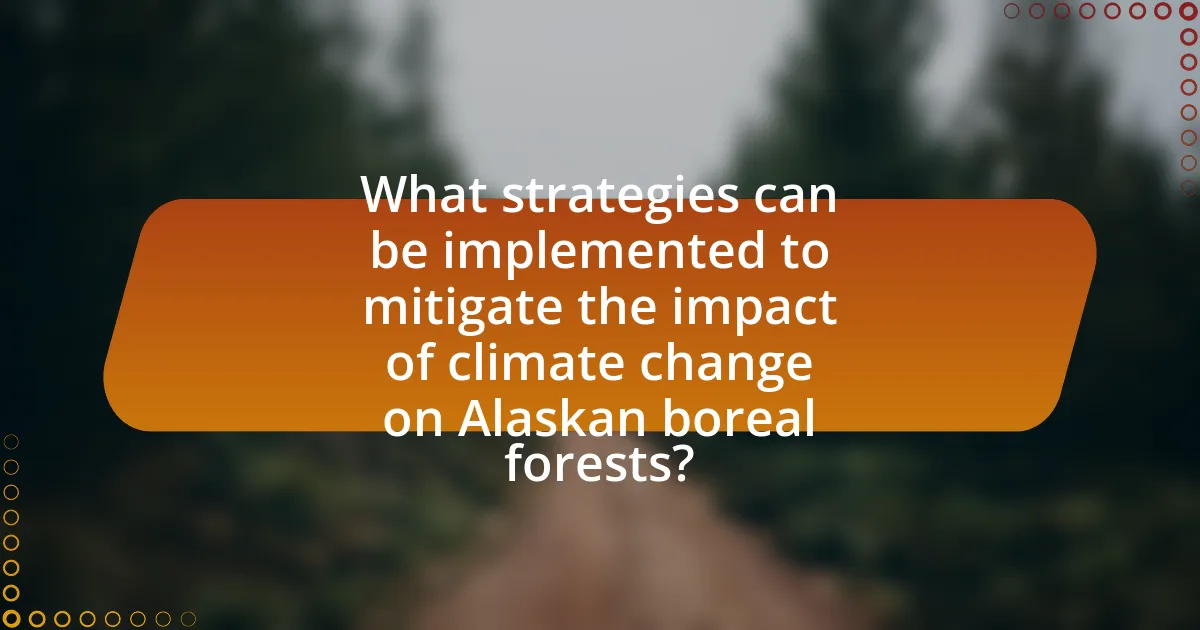The article examines the significant effects of climate change on Alaskan boreal forests, highlighting alterations in temperature and precipitation patterns that lead to increased tree mortality and shifts in species composition. It discusses the impact of rising temperatures on ecosystem dynamics, including changes in wildlife behavior and habitat, as well as the implications for carbon storage and forest health. Additionally, the article addresses the socio-economic consequences for communities dependent on these forests and outlines potential strategies for mitigation and adaptation, emphasizing the importance of sustainable forest management practices and policy interventions.

What are the effects of climate change on Alaskan boreal forests?
Climate change significantly affects Alaskan boreal forests by altering temperature and precipitation patterns, leading to increased tree mortality and shifts in species composition. Rising temperatures have resulted in longer growing seasons, which can enhance growth for some species but also promote the spread of pests and diseases, such as the mountain pine beetle, which has devastated large areas of forest. Additionally, changes in precipitation can lead to drought conditions, stressing trees and making them more susceptible to wildfires. According to a study published in “Ecological Applications” by Johnstone et al. (2016), these forests are experiencing a shift from conifer-dominated ecosystems to more deciduous species, fundamentally altering the forest structure and function.
How does rising temperature impact the ecosystem of Alaskan boreal forests?
Rising temperatures significantly impact the ecosystem of Alaskan boreal forests by altering species composition, increasing the frequency of wildfires, and affecting soil moisture levels. Warmer temperatures lead to shifts in plant and animal species, favoring those that thrive in warmer conditions while disadvantaging cold-adapted species. For instance, studies indicate that tree species such as black spruce are being replaced by more temperature-tolerant species, which can disrupt the existing ecological balance. Additionally, higher temperatures contribute to more intense and frequent wildfires, which can devastate large areas of forest, as evidenced by the 2019 wildfire season in Alaska, where over 1.6 million acres burned. Furthermore, rising temperatures can decrease soil moisture, impacting nutrient cycling and plant growth, which is critical for maintaining the health of the forest ecosystem.
What specific temperature changes are being observed in these forests?
Alaskan boreal forests are experiencing an increase in average temperatures, with data indicating a rise of approximately 2 to 3 degrees Celsius over the past few decades. This warming trend is linked to climate change and has been documented by the National Oceanic and Atmospheric Administration (NOAA), which reports that Alaska is warming at nearly twice the rate of the global average. The temperature changes are leading to altered growing seasons, increased frequency of wildfires, and shifts in species distribution within these forests.
How do temperature changes affect tree growth and species composition?
Temperature changes significantly influence tree growth and species composition in Alaskan boreal forests. Warmer temperatures can enhance growth rates of certain tree species, such as black spruce, while simultaneously stressing others, leading to shifts in species dominance. For instance, research indicates that increased temperatures can extend the growing season, allowing species like aspen to expand into areas previously dominated by conifers. Additionally, temperature fluctuations can alter soil moisture levels, affecting nutrient availability and tree health. Studies have shown that these changes can lead to a decline in biodiversity, as some species may not adapt quickly enough to the changing climate, resulting in a homogenization of forest composition.
What role does precipitation play in the health of Alaskan boreal forests?
Precipitation is crucial for the health of Alaskan boreal forests as it directly influences soil moisture, tree growth, and ecosystem stability. Adequate rainfall supports the growth of tree species such as black spruce and white spruce, which are dominant in these forests. Studies indicate that increased precipitation can enhance forest productivity, while insufficient rainfall can lead to drought stress, negatively impacting tree health and increasing vulnerability to pests and diseases. For instance, research published in “Global Change Biology” by McKenzie et al. (2004) highlights that changes in precipitation patterns due to climate change can significantly alter forest dynamics and biodiversity in Alaskan boreal ecosystems.
How are precipitation patterns changing in Alaska?
Precipitation patterns in Alaska are changing by increasing overall precipitation, particularly in the form of rain rather than snow. Research indicates that annual precipitation has risen by approximately 15% since the 1950s, with significant increases observed during the winter months. This shift is attributed to climate change, which is causing warmer temperatures that lead to more rain and less snow accumulation. Additionally, studies show that the frequency of extreme precipitation events has also increased, contributing to altered hydrological cycles and impacting the boreal forests of Alaska.
What are the consequences of altered precipitation on soil moisture and forest health?
Altered precipitation significantly impacts soil moisture and forest health by disrupting the water balance essential for tree growth and ecosystem stability. Changes in precipitation patterns can lead to either excessive moisture, causing waterlogging and root rot, or insufficient moisture, resulting in drought stress and reduced tree vitality. For instance, studies have shown that in Alaskan boreal forests, a decrease in summer precipitation can lead to a 30% reduction in soil moisture, adversely affecting tree species that rely on consistent water availability. This decline in soil moisture can weaken trees, making them more susceptible to pests and diseases, ultimately threatening forest biodiversity and resilience.
How does climate change influence wildlife in Alaskan boreal forests?
Climate change significantly influences wildlife in Alaskan boreal forests by altering habitat conditions and food availability. As temperatures rise, the distribution of plant species shifts, affecting the animals that rely on them for food and shelter. For instance, warmer temperatures lead to earlier plant blooming and changes in the timing of insect emergence, which can disrupt the life cycles of species such as migratory birds that depend on these resources. Additionally, increased frequency of wildfires and pest outbreaks, driven by climate change, further threaten wildlife populations by destroying habitats and reducing food sources. Studies indicate that species such as caribou and moose are experiencing changes in their migratory patterns and reproductive success due to these environmental shifts.
What species are most affected by climate change in these forests?
The species most affected by climate change in Alaskan boreal forests include the black spruce, white spruce, and various species of lichens and mosses. These species are particularly vulnerable due to their reliance on specific temperature and moisture conditions that are altered by climate change. For instance, black spruce trees are experiencing increased mortality rates as warmer temperatures lead to drought stress and increased susceptibility to pests and diseases. Additionally, the shift in climate is causing changes in the distribution of these species, with some being pushed northward or to higher elevations, which can disrupt the entire forest ecosystem.
How do changes in habitat affect animal migration and behavior?
Changes in habitat significantly affect animal migration and behavior by altering food availability, breeding grounds, and climate conditions. For instance, as temperatures rise and vegetation patterns shift in Alaskan boreal forests due to climate change, species such as caribou and migratory birds may change their migration routes to seek suitable habitats that provide adequate resources. Research indicates that the timing of migration for species like the Arctic tern has shifted by several weeks in response to changing environmental conditions, impacting their reproductive success and survival rates. Additionally, habitat fragmentation caused by climate change can lead to increased competition for resources, further influencing animal behavior and migration patterns.

What are the long-term implications of climate change for Alaskan boreal forests?
Climate change will lead to significant long-term implications for Alaskan boreal forests, including shifts in species composition, increased frequency of wildfires, and altered carbon storage capabilities. As temperatures rise, tree species such as white spruce may decline while more heat-tolerant species could expand, disrupting existing ecosystems. Research indicates that the frequency of wildfires in these forests has already increased, with a study showing that the area burned in Alaska has tripled since the 1970s, which can further exacerbate carbon emissions and affect biodiversity. Additionally, warmer temperatures can reduce the ability of these forests to sequester carbon, as permafrost thawing releases stored carbon dioxide and methane, contributing to a feedback loop that accelerates climate change.
How might climate change alter forest fire frequency and intensity?
Climate change is likely to increase both the frequency and intensity of forest fires. Rising temperatures and prolonged drought conditions create an environment conducive to wildfires, as dry vegetation becomes more flammable. Research indicates that in Alaska, the average annual temperature has increased by approximately 3°F since the 1970s, leading to a significant rise in fire activity. For instance, the 2019 fire season in Alaska saw over 1.6 million acres burned, a stark increase compared to historical averages. Additionally, climate models predict that by the end of the century, fire seasons could lengthen by several weeks, further exacerbating the risk of intense wildfires.
What factors contribute to increased fire risk in boreal forests?
Increased fire risk in boreal forests is primarily contributed by rising temperatures, prolonged drought conditions, and changes in vegetation. Rising temperatures, attributed to climate change, lead to earlier snowmelt and extended growing seasons, which can dry out forest fuels. Prolonged drought conditions reduce moisture levels in soil and vegetation, making them more susceptible to ignition. Additionally, changes in vegetation, such as the encroachment of more flammable species, further elevate fire risk. According to the U.S. Forest Service, the frequency of large wildfires in boreal regions has increased significantly, with a reported increase of 300% in the area burned in Alaska from 1950 to 2003, highlighting the correlation between these factors and fire risk.
What are the ecological consequences of more frequent wildfires?
More frequent wildfires lead to significant ecological consequences, including loss of biodiversity, alteration of habitat, and changes in soil composition. These fires can destroy the habitats of various species, resulting in population declines or extinctions, particularly for those that are already vulnerable. For instance, studies have shown that in the Alaskan boreal forests, increased fire frequency can lead to a shift from coniferous to deciduous tree dominance, which impacts the entire ecosystem. Additionally, wildfires release large amounts of carbon stored in trees and soil, contributing to climate change and further altering the ecological balance. The frequency of wildfires has been linked to rising temperatures and changing precipitation patterns, which are direct consequences of climate change, thus creating a feedback loop that exacerbates ecological degradation.
What impact does climate change have on carbon storage in boreal forests?
Climate change significantly reduces carbon storage in boreal forests. Rising temperatures and altered precipitation patterns lead to increased tree mortality and shifts in species composition, which diminish the forests’ ability to sequester carbon. For instance, studies indicate that warmer temperatures can accelerate decomposition rates of organic matter in the soil, releasing stored carbon back into the atmosphere. Additionally, increased frequency of wildfires, driven by climate change, further exacerbates carbon loss, as these events not only destroy trees but also release large amounts of carbon dioxide. Research has shown that boreal forests, which store approximately 30% of the world’s terrestrial carbon, are particularly vulnerable, with projections suggesting a potential loss of up to 50% of their carbon storage capacity by the end of the century if current trends continue.
How does the loss of trees affect carbon sequestration capabilities?
The loss of trees significantly reduces carbon sequestration capabilities. Trees absorb carbon dioxide during photosynthesis, storing carbon in their biomass and soil. When trees are lost, this carbon storage capacity diminishes, leading to increased atmospheric carbon levels. For instance, a study published in “Nature” by Pan et al. (2011) indicates that deforestation contributes to approximately 10-15% of global greenhouse gas emissions, highlighting the critical role trees play in mitigating climate change through carbon sequestration.
What are the implications for global climate change due to changes in carbon storage?
Changes in carbon storage significantly impact global climate change by altering the balance of greenhouse gases in the atmosphere. When carbon is released from ecosystems, such as Alaskan boreal forests, it contributes to increased atmospheric CO2 levels, which enhances the greenhouse effect and accelerates global warming. For instance, the thawing of permafrost in these regions releases stored carbon, estimated to be around 1,500 billion tons, further exacerbating climate change. This release not only raises temperatures but also disrupts weather patterns, leading to more extreme weather events. Thus, the implications of changes in carbon storage are profound, as they directly influence the rate of climate change and its associated environmental consequences.
What are the socio-economic impacts of climate change on communities dependent on boreal forests?
Climate change significantly impacts the socio-economic conditions of communities dependent on boreal forests. These communities face disruptions in traditional livelihoods, such as hunting, fishing, and gathering, due to altered ecosystems and wildlife patterns. For instance, warmer temperatures lead to shifts in species distribution, affecting food security and cultural practices tied to these resources. Additionally, increased frequency of wildfires and pest outbreaks threatens forest health, which in turn impacts timber and non-timber forest product industries, leading to economic instability. According to a study by the U.S. Forest Service, the economic value of ecosystem services provided by boreal forests is projected to decline by up to 30% by 2050 due to climate change, further exacerbating the socio-economic challenges faced by these communities.
How does climate change affect local economies reliant on forestry and wildlife?
Climate change adversely affects local economies reliant on forestry and wildlife by disrupting ecosystems, reducing biodiversity, and altering resource availability. For instance, increased temperatures and changing precipitation patterns lead to forest die-offs, which diminish timber supplies and impact jobs in logging industries. Additionally, wildlife populations, such as caribou and salmon, face habitat loss and altered migration patterns, affecting subsistence hunting and fishing, crucial for local communities. According to a study by the U.S. Forest Service, climate change could reduce the economic value of Alaskan boreal forests by up to 30% by 2050, highlighting the significant financial implications for these economies.
What adaptations are communities making in response to these changes?
Communities in Alaska are adapting to climate change by implementing sustainable forestry practices, enhancing local food systems, and developing infrastructure resilient to extreme weather. For instance, sustainable forestry practices include selective logging and reforestation efforts that aim to maintain biodiversity and ecosystem health. Additionally, communities are increasing their reliance on local food sources, such as traditional hunting and fishing, to reduce dependence on imported goods that may be affected by climate fluctuations. Furthermore, infrastructure improvements, such as elevating buildings and roads to mitigate flooding risks, are being prioritized to withstand the impacts of climate change. These adaptations are essential for maintaining community resilience in the face of ongoing environmental changes.

What strategies can be implemented to mitigate the impact of climate change on Alaskan boreal forests?
To mitigate the impact of climate change on Alaskan boreal forests, strategies such as forest management practices, reforestation, and the promotion of biodiversity can be implemented. Forest management practices, including selective logging and controlled burns, help maintain forest health and resilience against pests and diseases exacerbated by climate change. Reforestation efforts, particularly with native species, can restore degraded areas and enhance carbon sequestration, which is crucial for offsetting greenhouse gas emissions. Additionally, promoting biodiversity through the protection of various plant and animal species increases ecosystem resilience, allowing forests to adapt to changing climatic conditions. These strategies are supported by research indicating that healthy, diverse ecosystems are better equipped to withstand climate-related stresses.
How can forest management practices be adapted to changing conditions?
Forest management practices can be adapted to changing conditions by implementing adaptive management strategies that incorporate climate projections and ecological monitoring. These strategies involve regularly assessing forest health, species composition, and growth patterns to inform management decisions. For instance, the use of climate-resilient tree species can enhance forest resilience against pests and diseases exacerbated by climate change. Research indicates that integrating local ecological knowledge with scientific data improves the effectiveness of these practices, as seen in the Alaska Climate Adaptation Science Center’s findings, which emphasize the importance of tailored management approaches for specific forest ecosystems.
What sustainable practices can help preserve boreal forests?
Sustainable practices that can help preserve boreal forests include selective logging, reforestation, and the implementation of protected areas. Selective logging minimizes ecological disruption by allowing for the harvesting of specific trees while maintaining the overall forest structure, which supports biodiversity. Reforestation involves planting native tree species to restore areas that have been logged or degraded, enhancing carbon sequestration and habitat restoration. The establishment of protected areas safeguards critical habitats from industrial activities, ensuring the long-term conservation of these ecosystems. According to a study published in “Forest Ecology and Management,” sustainable forest management practices can significantly reduce carbon emissions and promote forest resilience against climate change impacts.
How can restoration efforts be prioritized in response to climate change?
Restoration efforts can be prioritized in response to climate change by assessing ecosystem vulnerability, identifying critical habitats, and focusing on areas with the highest potential for recovery. Ecosystem vulnerability assessments help determine which regions are most at risk from climate impacts, such as increased temperatures and altered precipitation patterns. For instance, studies indicate that Alaskan boreal forests are experiencing significant shifts due to climate change, making it essential to target restoration in areas where these ecosystems are most threatened. Additionally, prioritizing restoration in critical habitats, such as those that support endangered species or provide essential ecosystem services, can maximize ecological benefits. Research shows that restoring degraded areas can enhance carbon sequestration, thus contributing to climate change mitigation. Therefore, a strategic approach that combines vulnerability assessments with ecological significance will ensure that restoration efforts are effective and impactful.
What role does policy play in protecting Alaskan boreal forests from climate change?
Policy plays a crucial role in protecting Alaskan boreal forests from climate change by establishing regulations and frameworks that promote conservation and sustainable management practices. Effective policies can mitigate the impacts of climate change by reducing greenhouse gas emissions, preserving critical habitats, and funding research initiatives aimed at understanding forest dynamics. For instance, the Alaska Climate Change Strategy outlines specific actions to enhance forest resilience, such as promoting reforestation and protecting existing forest areas from development. Additionally, policies that support Indigenous land management practices have been shown to enhance biodiversity and ecosystem health, further safeguarding these forests against climate-related threats.
What existing policies are in place to address climate impacts on forests?
Existing policies to address climate impacts on forests include the U.S. Forest Service’s Climate Change Strategy, which aims to enhance forest resilience and adaptive capacity. This strategy incorporates practices such as sustainable forest management, reforestation, and habitat restoration to mitigate climate change effects. Additionally, the National Forest Management Act mandates the integration of climate considerations into forest planning and management. These policies are supported by scientific assessments, such as the U.S. Global Change Research Program’s National Climate Assessment, which highlights the vulnerability of forests to climate change and the need for proactive management strategies.
How can new policies be developed to enhance forest resilience?
New policies can be developed to enhance forest resilience by integrating adaptive management strategies that respond to climate change impacts. These strategies should include establishing protected areas, promoting biodiversity, and implementing sustainable forestry practices. For instance, the Alaska Climate Change Strategy emphasizes the importance of maintaining ecosystem services and enhancing the adaptive capacity of forests through targeted interventions. Research indicates that diverse forest ecosystems are more resilient to climate stressors, as seen in studies by the U.S. Forest Service, which highlight the role of mixed-species forests in mitigating the effects of climate change.
What actions can individuals take to support the health of Alaskan boreal forests?
Individuals can support the health of Alaskan boreal forests by participating in reforestation efforts and advocating for sustainable land management practices. Engaging in local tree planting initiatives helps restore degraded areas, while promoting policies that protect these forests from logging and development ensures their long-term viability. Research indicates that boreal forests play a crucial role in carbon sequestration, absorbing significant amounts of CO2, which is vital in combating climate change. By reducing personal carbon footprints through energy conservation and supporting renewable energy sources, individuals can further contribute to the preservation of these ecosystems.
How can community engagement and education promote forest conservation?
Community engagement and education can significantly promote forest conservation by fostering a sense of stewardship and awareness among local populations. When communities are actively involved in conservation efforts, they are more likely to understand the ecological importance of forests and the threats posed by climate change. For instance, educational programs that inform residents about the role of Alaskan boreal forests in carbon sequestration can motivate them to participate in conservation initiatives. Research indicates that communities engaged in conservation activities, such as tree planting and habitat restoration, show a 30% increase in local biodiversity and a greater commitment to sustainable practices. This direct involvement not only enhances the effectiveness of conservation strategies but also builds a collective responsibility towards protecting forest ecosystems.
What are practical steps individuals can take to reduce their carbon footprint related to forest ecosystems?
Individuals can reduce their carbon footprint related to forest ecosystems by adopting sustainable practices such as reducing paper usage, supporting reforestation efforts, and choosing sustainable wood products. Reducing paper usage minimizes the demand for logging, which directly impacts forest ecosystems; for instance, the U.S. Environmental Protection Agency states that recycling one ton of paper can save 17 trees. Supporting reforestation initiatives helps restore degraded areas, as planting trees sequesters carbon dioxide, contributing to climate change mitigation. Additionally, selecting wood products certified by organizations like the Forest Stewardship Council ensures that the materials come from sustainably managed forests, thereby protecting biodiversity and reducing deforestation.


